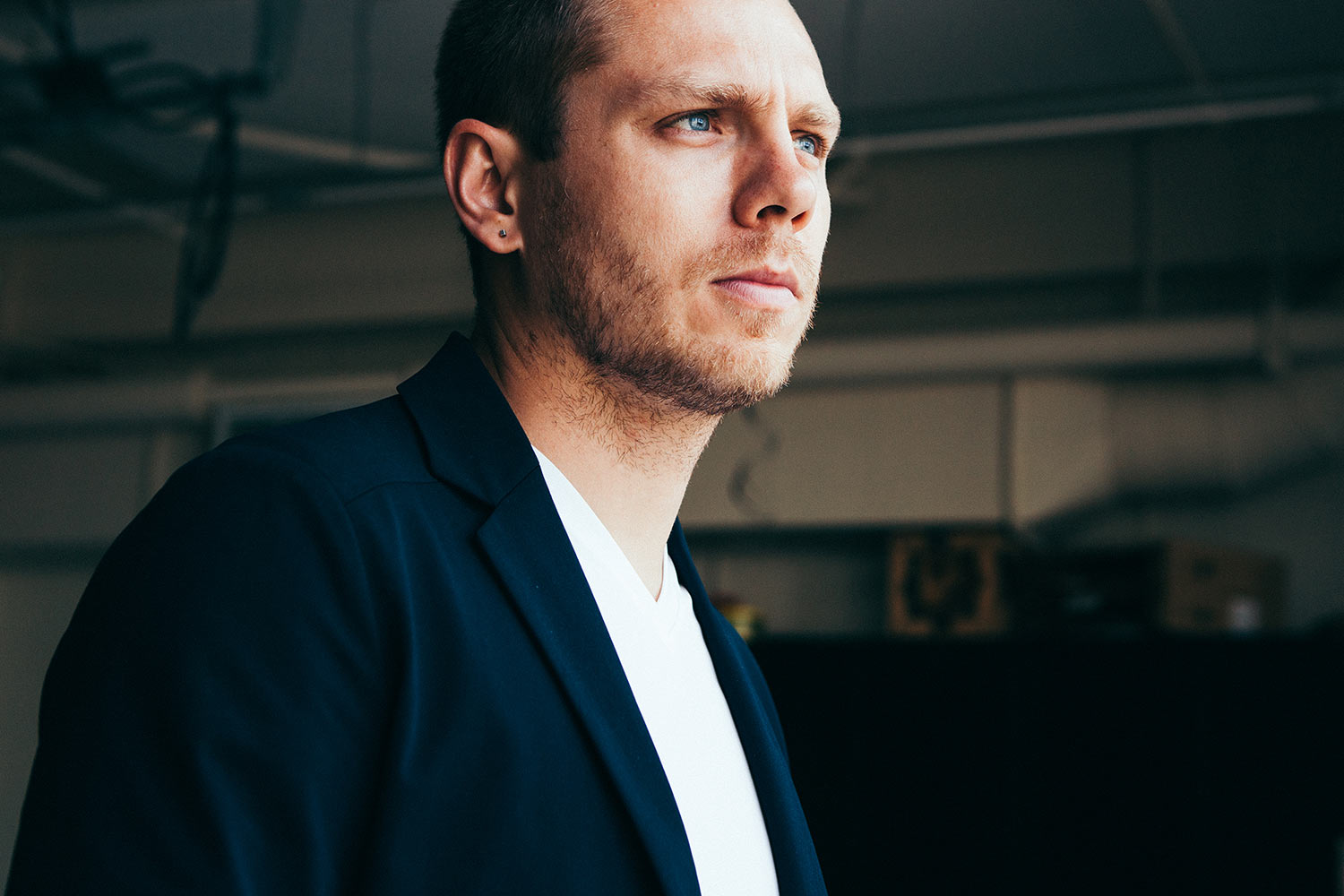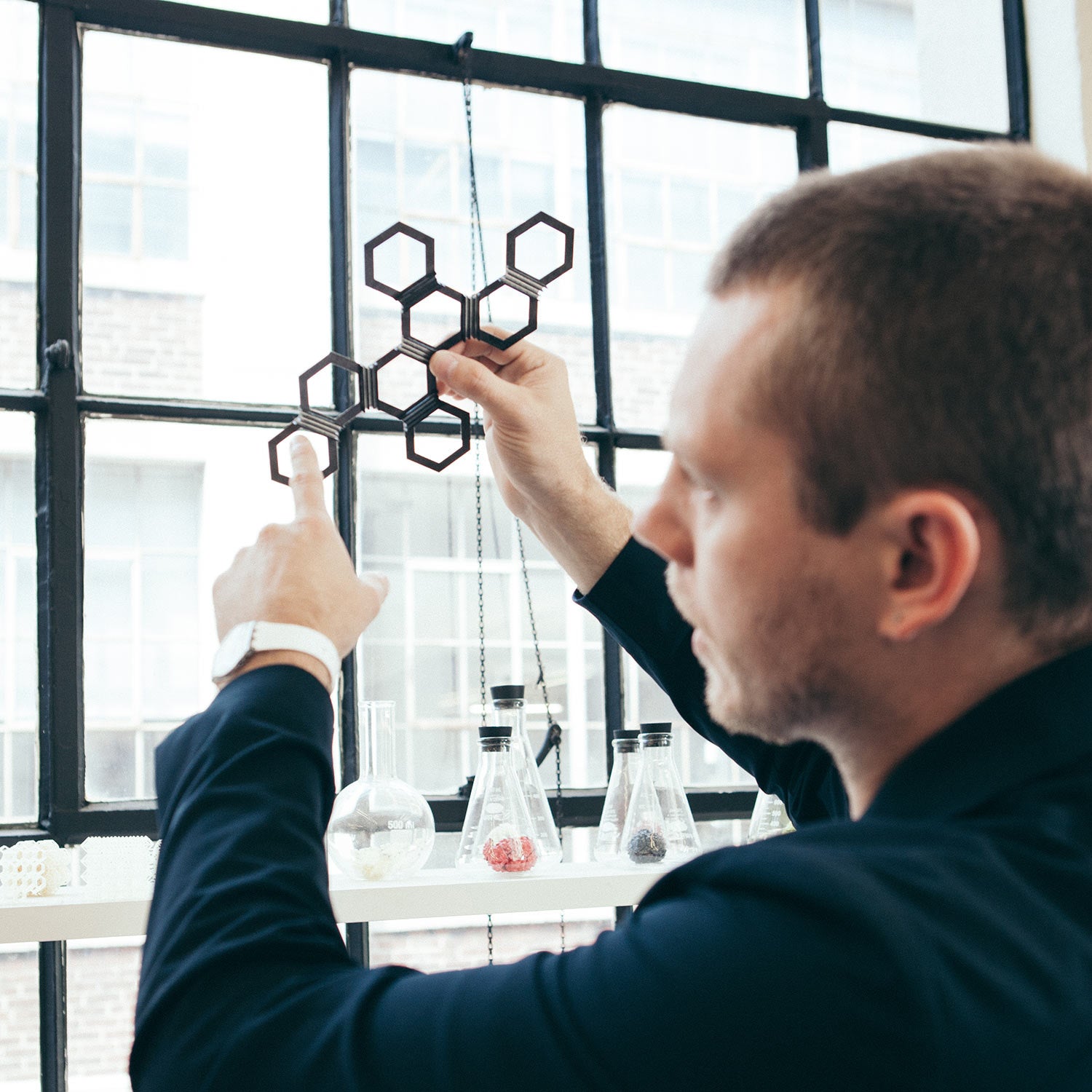row

Many times, the expected way is fine. Not great – but fine. We design for the guys who refuse to accept “fine.”
They’re the solvers – the ones reconsidering the problems that everyone else thought had already been reconciled. They believe there’s always a better way; and driven by curiosity and an inherent passion for the discovery process, they’ll work tirelessly until that better way is achieved.
Skylar Tibbits is that guy. A true pioneer in the field of self-assembly, Skylar's core focus is making sense of the unintuitive. He's already achieved TED-Fellow status (his 2013 TED Talk on 4D printing has over 2 million views) and the Self-Assembly Lab that he founded and directs at MIT continues to push the limits on what's possible with physical materials.
We spent an afternoon with Skylar in the Self-Assembly Lab to learn more about his research and what it means to introduce this fourth dimension – time – to design.
How did you get into self-assembly?
Originally, I was studying architecture. By the time I graduated with a professional degree, so many new software companies were booming and new digital fabrication tools were coming on board. I was getting really into writing code at that point and came to MIT to study design computation, and then I started another masters in computer science and began doing a lot of research with a lab called The Center for Bits and Atoms, which had a DARPA grant for programmable matter. The goal there was to program matter to change shape, property, morph between states, and so on. It soon became apparent that there were ways that physical things could assemble themselves for construction, which then became more focused on materials and passive systems that can transform in shape or property or build themselves.
There was an elegance in writing code and an elegance in running machines to digitally fabricate things, but there was no elegance in construction. It was like brute force, just slamming stuff together. So that’s where self-assembly came from – trying to take on the construction side by helping things in the physical world assemble just as they do in the digital world.
How did the MIT Self-Assembly Lab come about?
The need really just grew naturally. I was a grad student here, then hired as faculty and was teaching and doing research on a lot of projects, like the self-assembly structures. Interest and commitment around self-assembly grew, and I was able to focus on it full-time. That meant forming a lab, raising money, building a team, and securing space. The lab is now housed here in the International Design Center at MIT, which is home to a number of different labs from different departments all focused on design research. Officially we’re housed under the architecture department – that’s where my appointment is.
What motivates you to solve problems?
I think it relates to how we decide what to work on. From one end of the spectrum, we think about self-assembly as basic or fundamental research. We’re trying learn what’s possible, consider what we don’t know, and figure out how far can we push limits. It starts with asking, “What’s the craziest possible thing we can think of?” or, “What’s the most surprising thing that could ever happen?”. We’ll consider these really far-reaching concepts, then try and pinpoint why they're surprising but also how they're actually possible, and how to tap into that.
On the other end of the spectrum, we work on very applied research, and that tends to be with different companies and industries – from apparel to infrastructure to aviation, furniture, sports cars, and so on. These companies often come to us with challenges which we’ll try to apply technologies toward, or invent new technologies, or develop a roadmap that can take on a certain challenge.
And then a lot of it is about exploring a new space. There are so many technologies we’re working on or are interested in working on, and with which we know we can pave the way in an otherwise unfocused domain.
Is there a sustainability component to all of this? For example, would companies find partnership more attractive because self-assembly has a smaller footprint?
Yes and no. Remaining sustainable and energy efficient isn’t necessarily our main goal – it's more about pushing materials as far as we possibly can – but I do think there is an inherent connection. Because that’s how biology and chemistry are built, and how physics works. There is no top-down construction. It’s all through bottom-up interaction that leads to higher levels of order. So in that way, you can build systems that have a lot of the functionality we’ve seen in the natural world. But also we’re interested in trying to look at other types of energy. Instead of forms of energy we've gotten stuck on, like electric or fuel, we're looking at sound, light, temperature, moisture – what we call passive energy that’s readily abundant but hardly ever used to do more. Our vision is that these programmable materials can eliminate mechanisms like sensors, motors, and actuators, but still have all the logic, sensing, and actualization. And that makes it easier to produce, with less materials and less failure.
What helps you stay patient and focused through complications?
We encounter many, many complications. A lot of it takes patience, and I tend not to have so much patience. But instead of getting stuck on one reason that something doesn’t work, we’ll try a hundred versions and aim to figure out how to be surprised by an outcome, or why we’re surprised, rather than fighting surprise. Usually when something won’t do what you want it do, you’ll get mad – but those are really moments of opportunity because something unexpected happened. And you can harness that to continue doing unexpected things outside of what you traditionally would find. It’s really just about continually going, and then finding those moments of surprise and intuition and how they blend together. There are so many crazy projects we’re working on, with cool stuff at all different scales, that it’s hard to not be optimistic about all of it.

Matter acting on its own – it's just such a surreal concept. Are natural phenomenons like this the future for invention?
Yeah, even computers and machinery are becoming matter, which is really fascinating. We always thought that if you want something intelligent you need a computer, or you need a robot. But now materials and innate physical matter are behaving as if they were alive, or as if they’re computers. Because we’re learning so much – from synthetic biology to material science and chemistry, and new fabrication techniques that allow us to make things we weren’t able to make before – developments have just been crazy across the board. There was the software revolution, but now we’re in the midst of this hardware revolution, and the next big thing will be a materials revolution. It’s all just bursting at the seams right now.
What’s one thing you’ve learned recently?
We put on an event called the Active Matter Summit that brings together all these specialists – material scientists, physicists, computer scientists, architects – to talk about the future of materials. I was just at one of these events in Amsterdam and it was super inspiring. There were people there working on cloaking – like, invisibility cloaking, acoustic cloaking, structural, mechanical, thermal, and electrical cloaking. Basically you can have an input from one side of an object, and then at the other side, it’s as if it isn’t even there – stuff just bends around it. There are a lot of weird new things that people are discovering that often have to do with geometric relationships at micro to macro scales of constituent things, so you have this unintuitive phenomenon.
How do you choose your mentors?
I don’t think you really choose your mentors - they rather just emerge throughout life. You never really know if you’re inspired by someone or work well with them until it’s after the fact and you look back on many years, or you find yourself somewhere in the middle of it and you’re like, yeah, this person is really a mentor. It just kind of happens naturally with people who have different skills sets than your own, or who are successful in ways that you’re struggling with, or have different personal characteristics than your own. The people who are open to share and talk or collaborate and give advice tend to be the people you want to hang out with.
Shop


